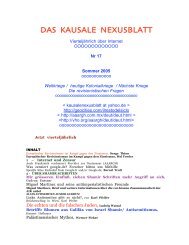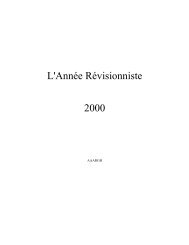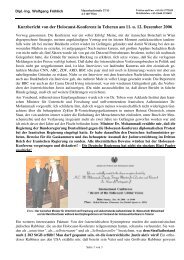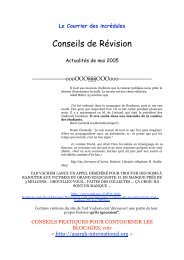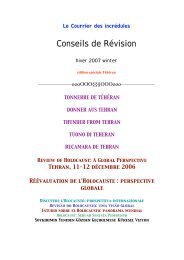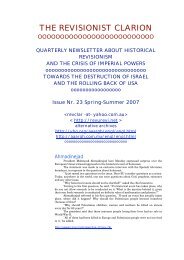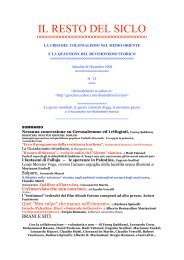Numéro 60--- ÃTà 2007 - Vho
Numéro 60--- ÃTà 2007 - Vho
Numéro 60--- ÃTà 2007 - Vho
You also want an ePaper? Increase the reach of your titles
YUMPU automatically turns print PDFs into web optimized ePapers that Google loves.
GAZETTE DU GOLFE ET DES BANLIEUES / <strong>60</strong> / ÉTÉ <strong>2007</strong><br />
out and drop powerful bombs over a populated area, and then learn that there have been a<br />
number of "unintended" casualties, and then the next day drop more bombs and learn again that<br />
there were "unintended" casualties, and then the next day you bomb again ... at what point do<br />
you lose the right to say that the deaths were "unintended"?<br />
During the US/NATO 78-day bombing of Serbia in 1999, which killed many civilians, a<br />
Belgrade office building -- which housed political parties, TV and radio stations, 100 private<br />
companies, and more -- was bombed. But before the missiles were fired into this building, NATO<br />
planners spelled out the risks: "Casualty Estimate 50-100 Government/Party employees.<br />
Unintended Civ Casualty Est: 250 -- Apts in expected blast radius."[11] The planners were<br />
saying that about 250 civilians living in nearby apartment buildings might be killed in the<br />
bombing, in addition to 50 to 100 government and political party employees, likewise innocent<br />
of any crime calling for execution. So what do we have here? We have grown men telling each<br />
other: We'll do A, and we think that B may well be the result. But even if B does in fact result,<br />
we're saying beforehand -- as we'll insist afterward -- that it was unintended.<br />
It was actually worse than this. As I've detailed elsewhere, the main purpose of the Serbian<br />
bombings -- admitted to by NATO officials -- was to make life so difficult for the public that<br />
support of the government of Slobodan Milosevic would be undermined.[12] This, in fact, is the<br />
classic definition of "terrorism", as used by the FBI and the United Nations: The use or threat of<br />
violence against a civilian population to induce the government to change certain policies.<br />
Another example of how "the enemy" can't be trusted to act as nice as god-fearing regular<br />
Americans ... "Defense officials said they believe at least 22 -- and possibly as many as 50 --<br />
former Guantánamo detainees have returned to the battlefield to fight against the United States<br />
and its allies."[13] The Defense Department has at times used the possibility of this happening as<br />
an argument against releasing detainees or closing Guantánamo.<br />
But is it imaginable, not to mention likely, that after three, four or five years in the hell on<br />
earth known as Guantánamo, even detainees not disposed to terrorist violence -- and many of<br />
them were picked up for reasons having nothing to do with terrorist violence -- left with a deepseated<br />
hatred of their jailors and a desire for revenge?<br />
Extract from The Anti-Empire Report Read this or George W. Bush will be president the rest of your life ,<br />
July 9, <strong>2007</strong><br />
http://members.aol.com/bblum6/aer47.htm<br />
L'INTROMISSION DE LA DÉMOCRATIE PAR LES VOIES BASSES<br />
Sodomy Returns to Afghanistan<br />
Timothy Bancroft-Hinchey<br />
The Taleban gone, the tradition of sodomy returns to Kandahar. Bearded men, accompanied<br />
by their “ashna” (beloved boys) are again openly visible on the streets.<br />
The Taleban had forbidden the Pashtun tradition of “ashna”, the grooming of favourite boys<br />
for sexual pleasure. In one of his first acts in 1994, Mullah Omar freed a boy who was being fought<br />
over by two Mujaheddin warlords in Kandahar, who had started firing artillery rounds at each other’s<br />
positions, destroying part of the city. Called to mediate in other such affairs, the Taleban movement<br />
quickly implanted itself in Kandahari society.<br />
The Taleban quickly applied their medieval rules to those caught practising sodomy: they were<br />
forced to stand under a stone wall, which was felled on top of them. Eye witnesses in Kandahar speak<br />
of the change under the Taleban, and the subsequent return of the ashna.<br />
One witness is the soldier Torjan. “In the later Mujaheddin years”, he told the British<br />
newspaper The Times, “more and more soldiers would take boys by force and keep them for as long<br />
as they wished. When the Taleban came, they were very strict about the ban”. However, the streets of<br />
Kandahar are now full of bearded men (usually married with families), walking openly accompanied<br />
by 15- or 16-year-old boys.<br />
— 72 —



